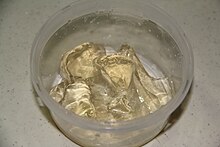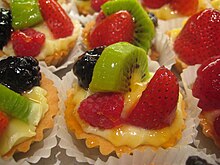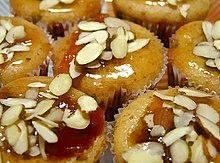
Dessert is a course that concludes a meal. The course consists of sweet foods, such as confections, and possibly a beverage such as dessert wine and liqueur. In some parts of the world, such as much of Greece and West Africa, and most parts of China, there is no tradition of a dessert course to conclude a meal.
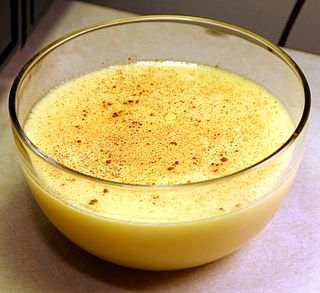
Custard is a variety of culinary preparations based on sweetened milk, cheese, or cream cooked with egg or egg yolk to thicken it, and sometimes also flour, corn starch, or gelatin. Depending on the recipe, custard may vary in consistency from a thin pouring sauce to the thick pastry cream used to fill éclairs. The most common custards are used in custard desserts or dessert sauces and typically include sugar and vanilla; however, savory custards are also found, e.g., in quiche.

Pastry is baked food made with a dough of flour, water and shortening that may be savoury or sweetened. Sweetened pastries are often described as bakers' confectionery. The word "pastries" suggests many kinds of baked products made from ingredients such as flour, sugar, milk, butter, shortening, baking powder, and eggs. Small tarts and other sweet baked products are called pastries as a synecdoche. Common pastry dishes include pies, tarts, quiches, croissants, and pasties.
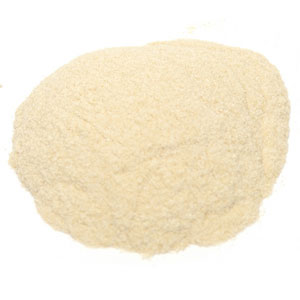
Pectin is a heteropolysaccharide, a structural acid contained in the primary lamella, in the middle lamella, and in the cell walls of terrestrial plants. The principal, chemical component of pectin is galacturonic acid which was isolated and described by Henri Braconnot in 1825. Commercially produced pectin is a white-to-light-brown powder, produced from citrus fruits for use as an edible gelling agent, especially in jams and jellies, dessert fillings, medications, and sweets; and as a food stabiliser in fruit juices and milk drinks, and as a source of dietary fiber.

A tart is a baked dish consisting of a filling over a pastry base with an open top not covered with pastry. The pastry is usually shortcrust pastry; the filling may be sweet or savoury, though modern tarts are usually fruit-based, sometimes with custard. Tartlet refers to a miniature tart; an example would be egg tarts. The categories of "tart", "flan", "quiche", and "pie" overlap, with no sharp distinctions.

A profiterole, cream puff (US), or chou à la crème is a filled French and Italian choux pastry ball with a typically sweet and moist filling of whipped cream, custard, pastry cream, or ice cream. The puffs may be decorated or left plain or garnished with chocolate sauce, caramel, or a dusting of powdered sugar. Savory profiterole are also made, filled with pureed meats, cheese, and so on. These were formerly common garnishes for soups.

A mille-feuille, also known by the names Napoleon, vanilla slice, and custard slice, is a dessert made of puff pastry layered with pastry cream. Its modern form was influenced by improvements made by Marie-Antoine Carême.

A hamantash is an Ashkenazi Jewish triangular filled-pocket pastry associated with the Jewish holiday of Purim. The name refers to Haman, the villain in the Purim story. In Hebrew, hamantashen are also known as אוזני המן, meaning "Haman's ears". "Haman's ears" also refers to a Sephardic Purim pastry, "Orejas de Haman", thought to originate in Spain and Italy, that is made by frying twisted or rolled strips of dough.

The Linzer torte is a traditional Austrian pastry, a form of shortbread topped with fruit preserves and sliced nuts with a lattice design on top. It is named after the city of Linz, Austria.

In cooking, a glaze is a glossy, translucent coating applied to the outer surface of a dish by dipping, dripping, or using a brush. Depending on its nature and intended effect, a glaze may be applied before or after cooking. It may be either sweet or savory ; typical glazes include brushed egg whites, some types of icing, and jam, and may or may not include butter, sugar, milk, oil, and fruit or fruit juice.

Fruit preserves are preparations of fruits whose main preserving agent is sugar and sometimes acid, often stored in glass jars and used as a condiment or spread.
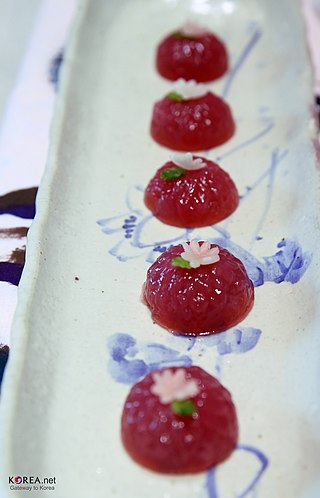
Gwapyeon is a jelly-like hangwa made with fruits. The colorful fruit jelly is commonly served at banquets. This classic dessert was served in the royal court during the Joseon dynasty.
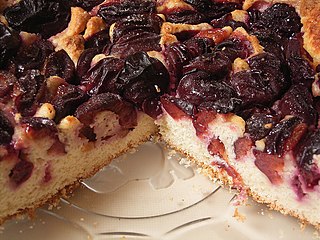
Plum cake refers to a wide range of cakes usually made with dried fruits such as currants, raisins, sultanas, or prunes, and also sometimes with fresh fruits. There is a wide range of popular plum cakes and puddings. Since the meaning of the word "plum" has changed over time, many items referred to as plum cakes and popular in England since at least the eighteenth century have now become known as fruitcake. The English variety of plum cake also exists on the European mainland, but may vary in ingredients and consistency. British colonists and missionaries brought the dried fruit variety of cake with them, for example, in British India where it was served around the time of the Christmas holiday season. In America's Thirteen Colonies, where it became associated with elections, one version came to be called "election cake".
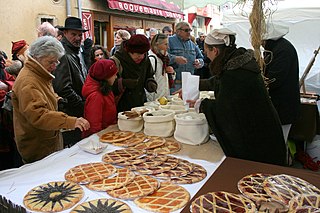
Tarte des Alpes is a pastry found specifically in the Southern Alps. It is filled with jam and covered with lattice patterns of pastry. Handmade by pastry chefs in the Hautes-Alpes and the Alpes-de-Haute-Provence or industrially made by some manufacturers. It has the advantage of being able to be kept for months without losing its flavour.
The first season of The Great Canadian Baking Show premiered on CBC Television on November 1, 2017. Ten amateur bakers competed over eight weeks of challenges throughout the competition for the title.
The second season of The Great Canadian Baking Show premiered on CBC Television on September 19, 2018. Ten amateur bakers competed over eight weeks of challenges throughout the competition for the title. Canadian actor and television personality Dan Levy and Canadian-British actress Julia Chan returned as hosts, with French-born Canadian chef Bruno Feldeisen and Canadian-Australian pastry chef Rochelle Adonis also returning as judges. For the second season, producer Marike Emery stated that the audition process prioritized "skill over personality" and that the tasks would be more challenging than the first season.

Vörtbröd is a sweet Scandinavian rye bread, associated with Swedish cuisine. It is a yeast-leavened spice loaf, sweetened with brown sugar and molasses which comes in a large variety in regards to whether or not butter-enriched, and which spices are being used. Traditional bread spices are anise, caraway, fennel seeds, and bitter orange.
